Monitoring Quarry Area with Landsat Long Time-Series for Socioeconomic Study
Abstract
:1. Introduction
2. Study Area
3. Materials and Methods
3.1. Data
3.2. Methods
3.2.1. Pre-Processing
3.2.2. Classification
3.2.3. Post-Processing
3.2.4. Calculation of Quarry Area
4. Results
4.1. Classification Accuracy
4.2. Quarry Time Series
4.3. Uncertainties and Errors
5. Social Discussion
5.1. Comparison of Two Regions
5.2. Relationship between Quarry Area and GRP
6. Conclusions
Acknowledgments
Author Contributions
Conflicts of Interest
Appendix A
| Sensor | ID | WRS_2 PATH/ROW | DATE |
|---|---|---|---|
| LANDSAT 5/TM | LT51230321984133HAJ00 | 123/032 | 12 May 1984 |
| LANDSAT 5/TM | LT51220321985128HAJ00 | 122/032 | 8 May 1985 |
| LANDSAT 5/TM | LT51220321986147HAJ00 | 122/032 | 27 May 1986 |
| LANDSAT 5/TM | LT51220321987166BJC00 | 122/032 | 15 June 1987 |
| LANDSAT 5/TM | LT51230321988128BJC00 | 123/032 | 7 May 1988 |
| LANDSAT 5/TM | LT51220321989139HAJ00 | 122/032 | 19 May 1989 |
| LANDSAT 5/TM | LT51220321990142HAJ00 | 122/032 | 22 May 1990 |
| LANDSAT 5/TM | LT51230321991136HAJ00 | 123/032 | 16 May 1991 |
| LANDSAT 5/TM | LT51230321992139BJC00 | 123/032 | 18 May 1992 |
| LANDSAT 5/TM | LT51220321993134HAJ00 | 122/032 | 14 May 1993 |
| LANDSAT 5/TM | LT51220321994137HAJ00 | 122/032 | 17 May 1994 |
| LANDSAT 5/TM | LT51220321995124BJC00 | 122/032 | 4 May 1995 |
| LANDSAT 5/TM | LT51230321996134CLT00 | 123/032 | 13 May 1996 |
| LANDSAT 5/TM | LT51230321997136BJC00 | 123/032 | 16 May 1997 |
| LANDSAT 5/TM | LT51220321998132HAJ00 | 122/032 | 12 May 1998 |
| LANDSAT 5/TM | LT51230321999126BJC01 | 123/032 | 6 May 1999 |
| LANDSAT 5/TM | LT51230322000129BJC00 | 123/032 | 8 May 2000 |
| LANDSAT 5/TM | LT51230322001131HAJ00 | 123/032 | 11 May 2001 |
| LANDSAT 5/TM | LT51220322002143BJC00 | 122/032 | 23 May 2002 |
| LANDSAT 5/TM | LT51230322003137BJC00 | 123/032 | 17 May 2003 |
| LANDSAT 5/TM | LT51230322004140BJC00 | 123/032 | 19 May 2004 |
| LANDSAT 5/TM | LT51230322005126BJC00 | 123/032 | 6 May 2005 |
| LANDSAT 5/TM | LT51220322006122BJC00 | 122/032 | 2 May 2006 |
| LANDSAT 5/TM | LT51230322007148IKR00 | 123/032 | 28 May 2007 |
| LANDSAT 5/TM | LT51230322008215BJC00 | 123/032 | 2 August 2008 |
| LANDSAT 5/TM | LT51230322009137IKR01 | 123/032 | 17 May 2009 |
| LANDSAT 5/TM | LT51220322010133IKR01 | 122/032 | 13 May 2010 |
| LANDSAT 5/TM | LT51220322011136IKR01 | 122/032 | 16 May 2011 |
| LANDSAT 8/OLI | LC81230322013132LGN03 | 123/032 | 12 May 2013 |
| LANDSAT 8/OLI | LC81230322014135LGN01 | 123/032 | 15 May 2014 |
| LANDSAT 8/OLI | LC81230322015138LGN01 | 123/032 | 18 May 2015 |
| LANDSAT 8/OLI | LC81220322016134LGN00 | 122/032 | 13 May 2016 |
| LANDSAT 8/OLI | LC81230322017143LGN00 | 123/032 | 23 May 2017 |
| Total | 33 |
References
- Saroglu, E.; Bektas, F.; Dogru, A.O.; Ormeci, C.; Musaoglu, N.; Kaya, S. Environmental Impact Analyses of Quarries Located on the Asian Side of Istanbul Using Remotely Sensed Data. Available online: http://www.cartesianos.com/geodoc/icc2005/pdf/poster/TEMA10/ELIF%20SAROGLU.pdf (accessed on 21 March 2018).
- Anderson, A.T.; Schultz, D.; Buchman, N.; Nock, H.M. Landsat imagery for surface-mine inventory. Photogramm. Eng. Remote Sens. 1977, 43, 1027–1036. [Google Scholar]
- Bonifazi, G.; Cutaia, L.; Massacci, P.; Roselli, I. Monitoring of abandoned quarries by remote sensing and in situ surveying. Ecol. Model. 2003, 170, 213–218. [Google Scholar] [CrossRef]
- Uça, A.Z.D.; Karaman, M.; Özelkan, E. Use of remote sensing in determining the environmental effects of open pit mining and monitoring the recultivation process. In Proceedings of the The International Mining Congress & Exhibition of Turkey, Ankara, Turkey, 11–13 May 2011. [Google Scholar]
- Nikolakopoulos, K.G.; Tsombos, P.I.; Vaiopoulos, A.D. Monitoring a quarry using high resolution data and gis techniques. Earth Resour. Environ. Remote Sens./GIS Appl. 2010, 7381. [Google Scholar] [CrossRef]
- Liu, C.C.; Wu, C.A.; Shieh, M.L.; Liu, J.G.; Lin, C.W.; Shieh, C.L. Monitoring the illegal quarry mining of gravel on the riverbed using daily revisit formosat-2 imagery. In Proceedings of the IGARSS’05 IEEE International Geoscience and Remote Sensing Symposium, Seoul, Korea, 29–29 July 2005; pp. 1777–1780. [Google Scholar]
- Nikolakopoulos, K.G.; Raptis, I. Open quarry monitoring using gap-filled landsat 7 etm slc-off imagery. In Proceedings of the SPIE Remote Sensing, Amsterdam, The Netherlands, 22–25 September 2014. [Google Scholar]
- Koruyan, K.; Deliormanli, A.H.; Karaca, Z.; Momayez, M.; Lu, H.; Yalcin, E. Remote sensing in management of mining land and proximate habitat. J. South. Afr. Inst. Min. Metall. 2012, 112, 667–672. [Google Scholar]
- Karuppasamy, S.; Kaliappan, S.; Karthiga, R.; Divya, C. Surface area estimation, volume change detection in lime stone quarry, tirunelveli district using cartosat-1 generated digital elevation model (dem). Circuits Syst. 2016, 7, 849–858. [Google Scholar] [CrossRef]
- Latifovic, R.; Fytas, K.; Chen, J.; Paraszczak, J. Assessing land cover change resulting from large surface mining development. Int. J. Appl. Earth Obs. Geoinf. 2005, 7, 29–48. [Google Scholar] [CrossRef]
- Kennedy, R.E.; Cohen, W.B.; Schroeder, T.A. Trajectory-based change detection for automated characterization of forest disturbance dynamics. Remote Sens. Environ. 2007, 110, 370–386. [Google Scholar] [CrossRef]
- Hansen, M.C.; Potapov, P.V.; Moore, R.; Hancher, M.; Turubanova, S.; Tyukavina, A.; Thau, D.; Stehman, S.V.; Goetz, S.J.; Loveland, T.R.; et al. High-resolution global maps of 21st-century forest cover change. Science 2014, 344, 850–853. [Google Scholar] [CrossRef] [PubMed]
- Rosenau, R.; Scheinert, M.; Dietrich, R. A processing system to monitor greenland outlet glacier velocity variations at decadal and seasonal time scales utilizing the landsat imagery. Remote Sens. Environ. 2015, 169, 1–19. [Google Scholar] [CrossRef]
- Macander, M.J.; Swingley, C.S.; Joly, K.; Raynolds, M.K. Landsat-based snow persistence map for northwest alaska. Remote Sens. Environ. 2015, 163, 23–31. [Google Scholar] [CrossRef]
- Robert, F.; Ian, O.; Alice, D.; Darren, P. A method for trend-based change analysis in arctic tundra using the 25-year landsat archive. Polar Rec. 2012, 48, 83–93. [Google Scholar]
- Fraser, R.; Olthof, I.; Kokelj, S.; Lantz, T.; Lacelle, D.; Brooker, A.; Wolfe, S.; Schwarz, S. Detecting landscape changes in high latitude environments using landsat trend analysis: 1. Visualization. Remote Sens. 2014, 6, 11533–11557. [Google Scholar] [CrossRef]
- Nitze, I.; Grosse, G.; Jones, B.M.; Arp, C.D.; Ulrich, M.; Fedorov, A.; Veremeeva, A. Landsat-based trend analysis of lake dynamics across northern permafrost regions. Remote Sens. 2017, 9, 640. [Google Scholar] [CrossRef]
- Olthof, I.; Fraser, R.H. Detecting landscape changes in high latitude environments using landsat trend analysis: 2. Classification. Remote Sens. 2014, 6, 11558–11578. [Google Scholar] [CrossRef]
- Gorelick, N.; Hancher, M.; Dixon, M.; Ilyushchenko, S.; Thau, D.; Moore, R. Google earth engine: Planetary-scale geospatial analysis for everyone. Remote Sens. Environ. 2017, 202, 18–27. [Google Scholar] [CrossRef]
- Goldblatt, R.; You, W.; Hanson, G.; Khandelwal, A. Detecting the boundaries of urban areas in india: A dataset for pixel-based image classification in google earth engine. Remote Sens. 2016, 8, 634. [Google Scholar] [CrossRef]
- Johansen, K.; Phinn, S.; Taylor, M. Mapping woody vegetation clearing in queensland, australia from landsat imagery using the google earth engine. Remote Sens. Appl. Soc. Environ. 2015, 1, 36–49. [Google Scholar] [CrossRef]
- Elvidge, C.D.; Baugh, K.E.; Kihn, E.A.; Kroehl, H.W.; Davis, E.R.; Davis, C.W. Relation between satellite observed visible-near infrared emissions, population, economic activity and electric power consumption. Int. J. Remote Sens. 1997, 18, 1373–1379. [Google Scholar] [CrossRef]
- Doll, C.N.H.; Muller, J.P.; Morley, J.G. Mapping regional economic activity from night-time light satellite imagery. Ecol. Econ. 2006, 57, 75–92. [Google Scholar] [CrossRef]
- Li, X.; Xu, H.; Chen, X.; Li, C. Potential of npp-viirs nighttime light imagery for modeling the regional economy of china. Remote Sens. 2013, 5, 3057–3081. [Google Scholar] [CrossRef]
- Forbes, D.J. Multi-scale analysis of the relationship between economic statistics and dmsp-ols night light images. Map. Sci. Remote Sens. 2013, 50, 483–499. [Google Scholar]
- Moknatian, M.; Piasecki, M.; Gonzalez, J. Development of geospatial and temporal characteristics for hispaniola’s lake azuei and enriquillo using landsat imagery. Remote Sens. 2017, 9, 510. [Google Scholar] [CrossRef]
- USGS. The Final Journey of Landsat 5: A Decommissioning Story. Available online: https://landsat.usgs.gov/final-journey-landsat-5-decommissioning-story (accessed on 12 February 2018).
- Irons, J.R.; Loveland, T.R. Eighth landsat satellite becomes operational. Photogramm. Eng. Remote Sens. 2013, 79, 398–401. [Google Scholar]
- Masek, J.G.; Vermote, E.F.; Saleous, N.E.; Wolfe, R.; Hall, F.G.; Huemmrich, K.F.; Gao, F.; Kutler, J.; Lim, T.K. A landsat surface reflectance dataset for north america, 1990–2000. IEEE Geosci. Remote Sens. Lett. 2006, 3, 68–72. [Google Scholar] [CrossRef]
- Vermote, E.; Justice, C.; Claverie, M.; Franch, B. Preliminary analysis of the performance of the landsat 8/oli land surface reflectance product. Remote Sens. Environ. 2016, 185, 46–56. [Google Scholar] [CrossRef]
- Bureau of Statistics of Hebei. Hebei Economic Yearbook; China Statistics Press: China, 1991–2017; Volume 7–32.
- Crist, E.P. A tm tasseled cap equivalent transformation for reflectance factor data. Remote Sens. Environ. 1985, 17, 301–306. [Google Scholar] [CrossRef]
- Huang, C.; Wylie, B.; Yang, L.; Homer, C.; Zylstra, G. Derivation of a tasselled cap transformation based on landsat 7 at-satellite reflectance. Int. J. Remote Sens. 2002, 23, 1741–1748. [Google Scholar] [CrossRef]
- Baig, M.H.A.; Zhang, L.; Tong, S.; Tong, Q. Derivation of a tasselled cap transformation based on landsat 8 at-satellite reflectance. Remote Sens. Lett. 2014, 5, 423–431. [Google Scholar] [CrossRef]
- Rouse, J.W., Jr.; Haas, R.H.; Schell, J.A.; Deering, D.W. Monitoring vegetation systems in the great plains with erts. NASA Spec. Publ. 1973, 351, 309–317. [Google Scholar]
- Gao, B.C. Ndwi—A normalized difference water index for remote sensing of vegetation liquid water from space. Remote Sens. Environ. 1996, 58, 257–266. [Google Scholar] [CrossRef]
- Zha, Y.; Gao, J.; Ni, S. Use of normalized difference built-up index in automatically mapping urban areas from tm imagery. Int. J. Remote Sens. 2003, 24, 583–594. [Google Scholar] [CrossRef]
- Breiman, L. Random forests. Mach. Learn. 2001, 45, 5–32. [Google Scholar] [CrossRef]
- Nitze, I.; Barrett, B.; Cawkwell, F. Temporal optimisation of image acquisition for land cover classification with random forest and modis time-series. Int. J. Appl. Earth Obs. Geoinf. 2015, 34, 136–146. [Google Scholar] [CrossRef]
- Barrett, B.; Nitze, I.; Green, S.; Cawkwell, F. Assessment of multi-temporal, multi-sensor radar and ancillary spatial data for grasslands monitoring in ireland using machine learning approaches. Remote Sens. Environ. 2014, 152, 109–124. [Google Scholar] [CrossRef]
- Belgiu, M.; Drăguţ, L. Random forest in remote sensing: A review of applications and future directions. ISPRS J. Photogramm. Remote Sens. 2016, 114, 24–31. [Google Scholar] [CrossRef]
- Topouzelis, K.; Psyllos, A. Oil spill feature selection and classification using decision tree forest on sar image data. ISPRS J. Photogramm. Remote Sens. 2012, 68, 135–143. [Google Scholar] [CrossRef]
- Breiman, L. Bagging predictors. Mach. Learn. 1996, 24, 123–140. [Google Scholar] [CrossRef]
- Wolpert, D.H.; Macready, W.G. An efficient method to estimate bagging’s generalization error. Mach. Learn. 1999, 35, 41–55. [Google Scholar] [CrossRef]
- Cutler, D.R.; Edwards, T.C., Jr.; Beard, K.H.; Cutler, A.; Hess, K.T.; Gibson, J.; Lawler, J.J. Random forests for classification in ecology. Ecology 2007, 88, 2783–2792. [Google Scholar] [CrossRef] [PubMed]
- Cánovas-García, F.; Alonso-Sarría, F.; Gomariz-Castillo, F.; Oñate-Valdivieso, F. Modification of the random forest algorithm to avoid statistical dependence problems when classifying remote sensing imagery. Comput. Geosci. 2017, 103, 1–11. [Google Scholar] [CrossRef]
- Guan, H.; Li, J.; Chapman, M.; Deng, F.; Ji, Z.; Yang, X. Integration of orthoimagery and lidar data for object-based urban thematic mapping using random forests. Int. J. Remote Sens. 2013, 34, 5166–5186. [Google Scholar] [CrossRef]
- Du, P.; Samat, A.; Waske, B.; Liu, S.; Li, Z. Random forest and rotation forest for fully polarized sar image classification using polarimetric and spatial features. ISPRS J. Photogramm. Remote Sens. 2015, 105, 38–53. [Google Scholar] [CrossRef]
- Rodriguez-Galiano, V.F.; Ghimire, B.; Rogan, J.; Chica-Olmo, M.; Rigol-Sanchez, J.P. An assessment of the effectiveness of a random forest classifier for land-cover classification. ISPRS J. Photogramm. Remote Sens. 2012, 67, 93–104. [Google Scholar] [CrossRef]



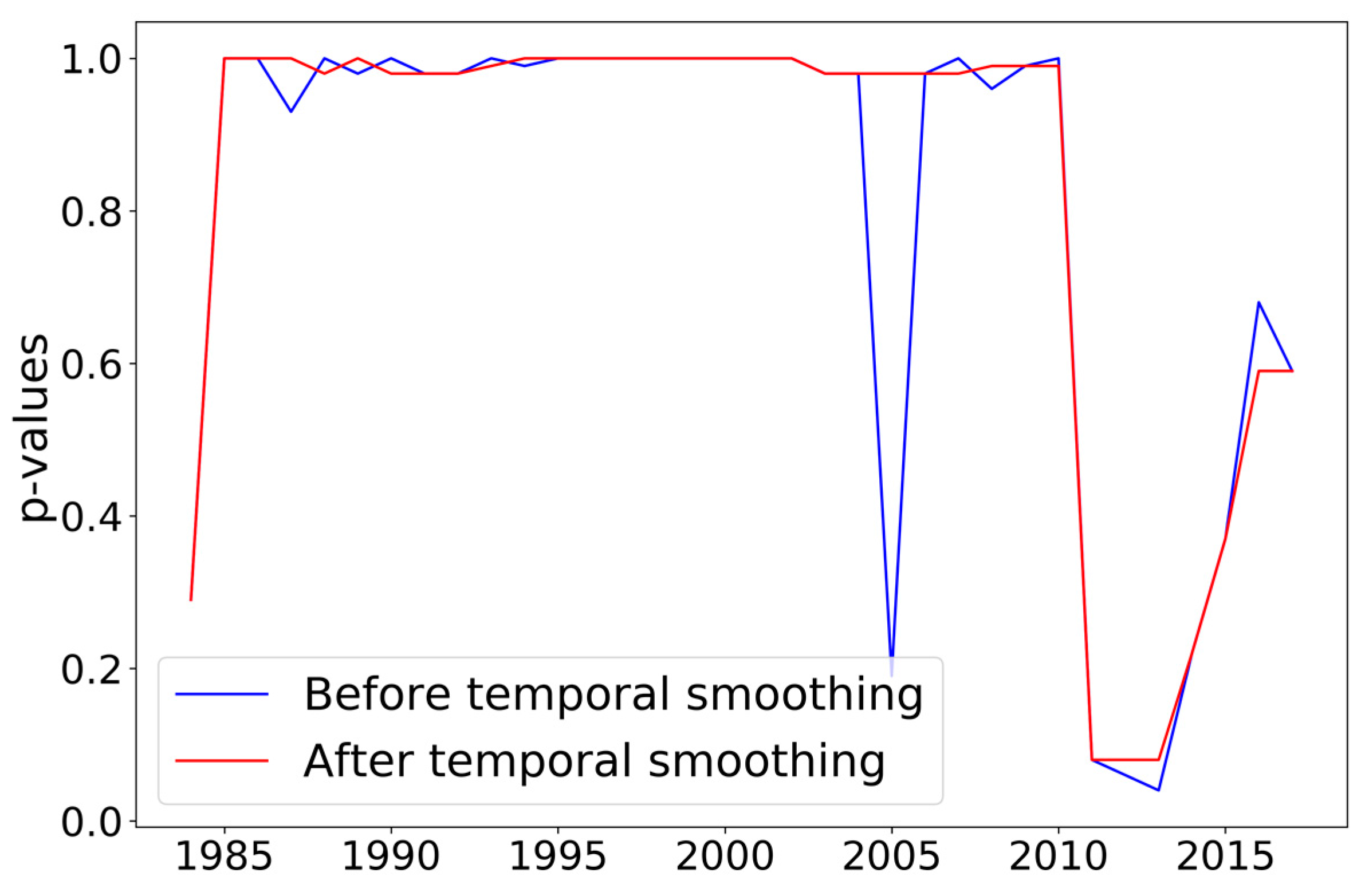
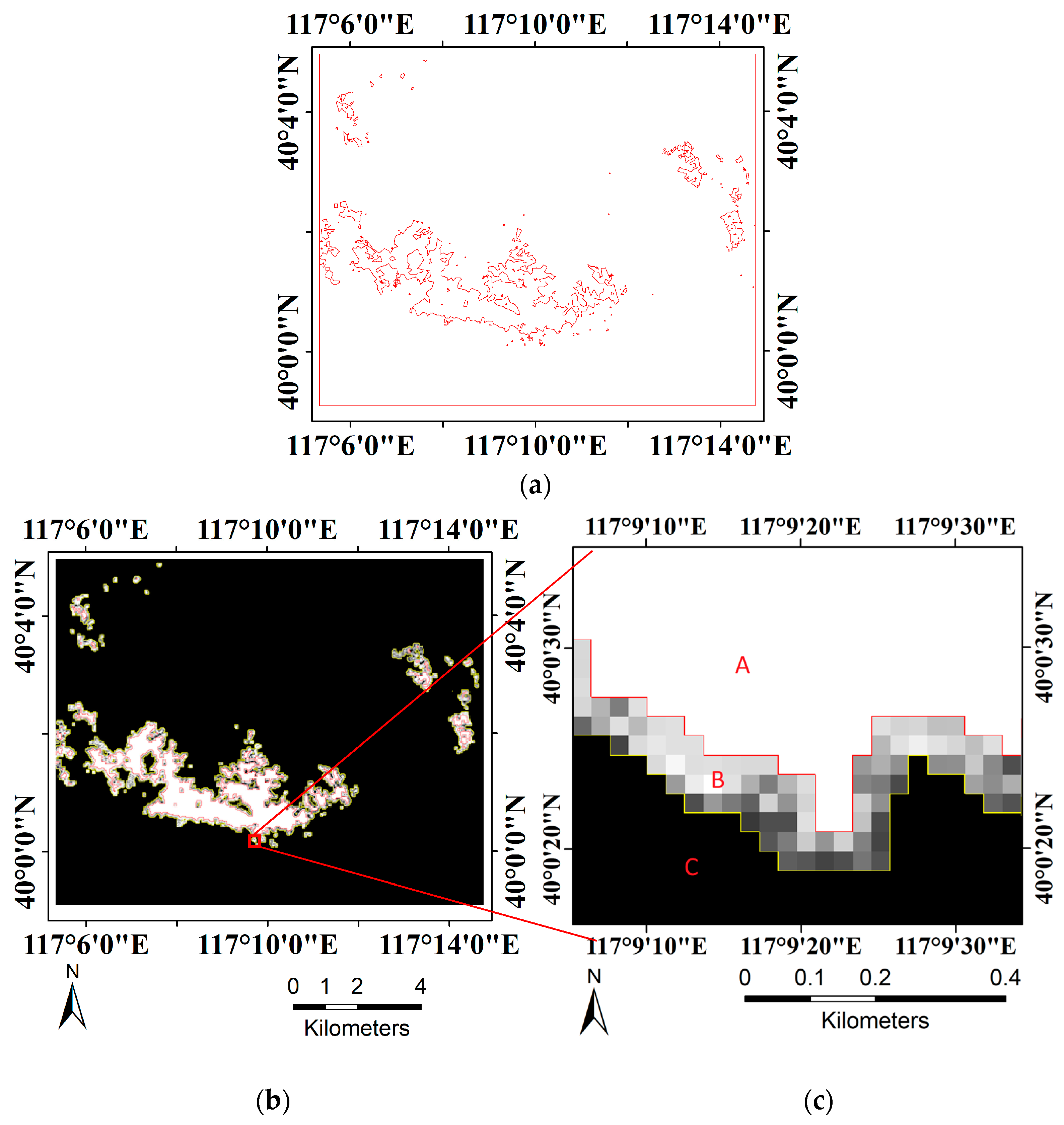


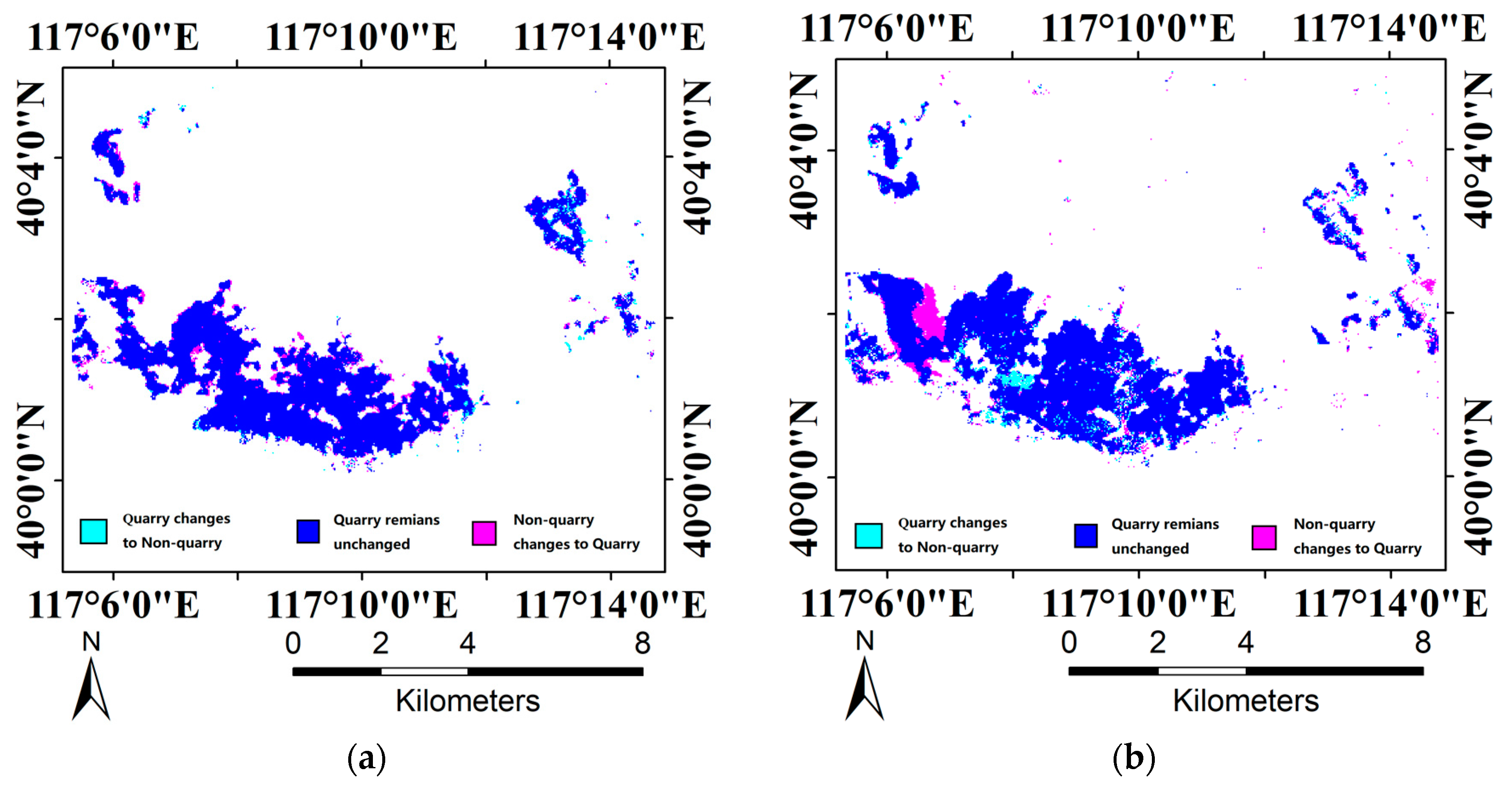
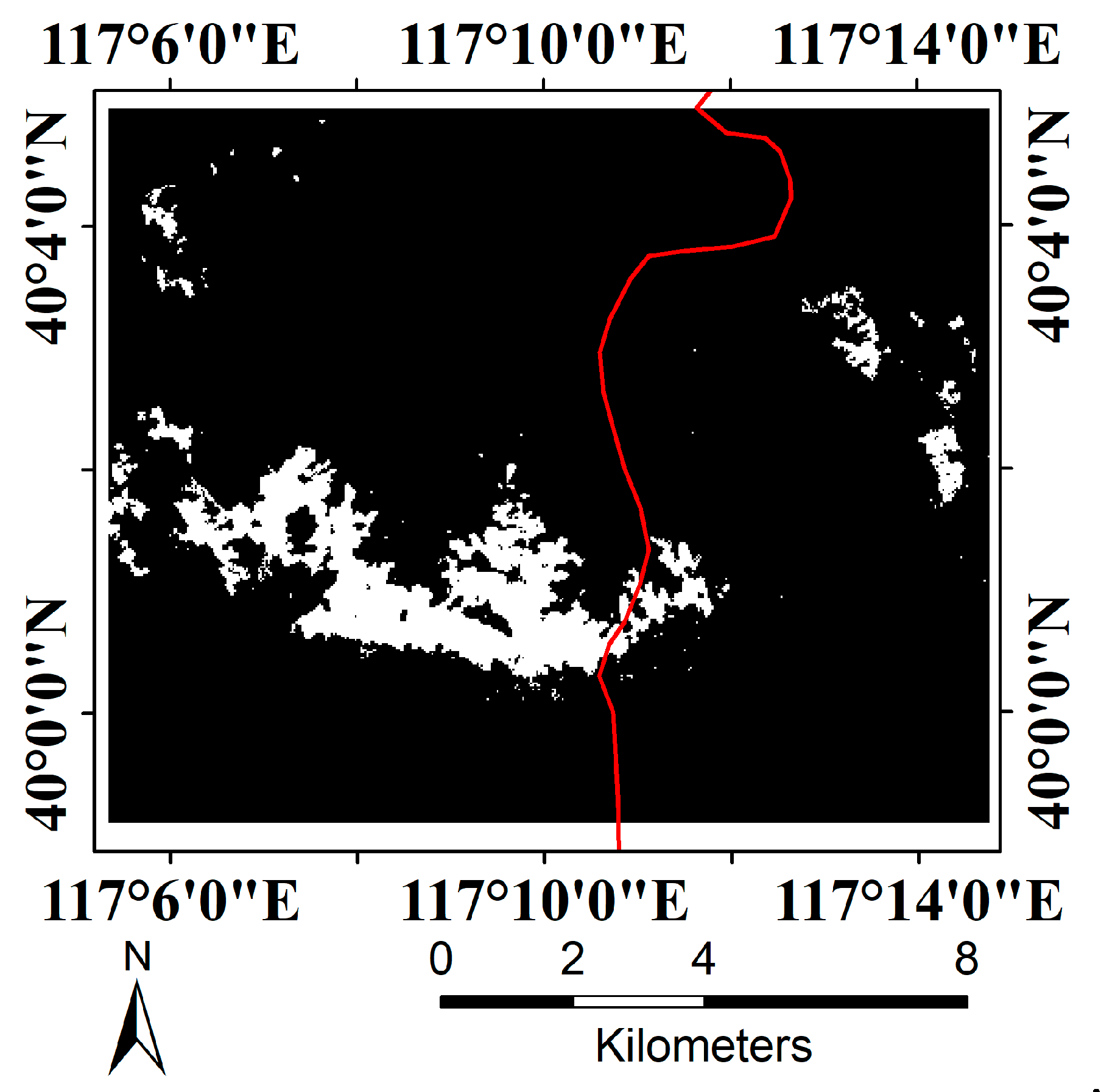

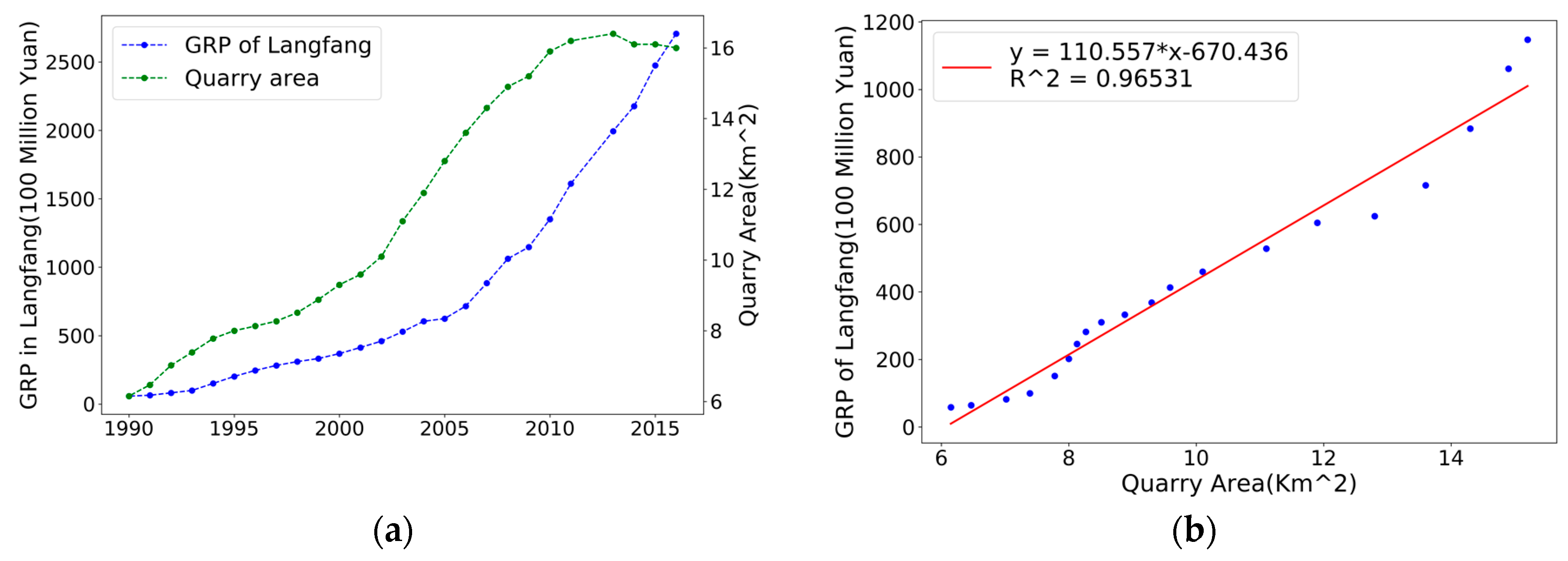
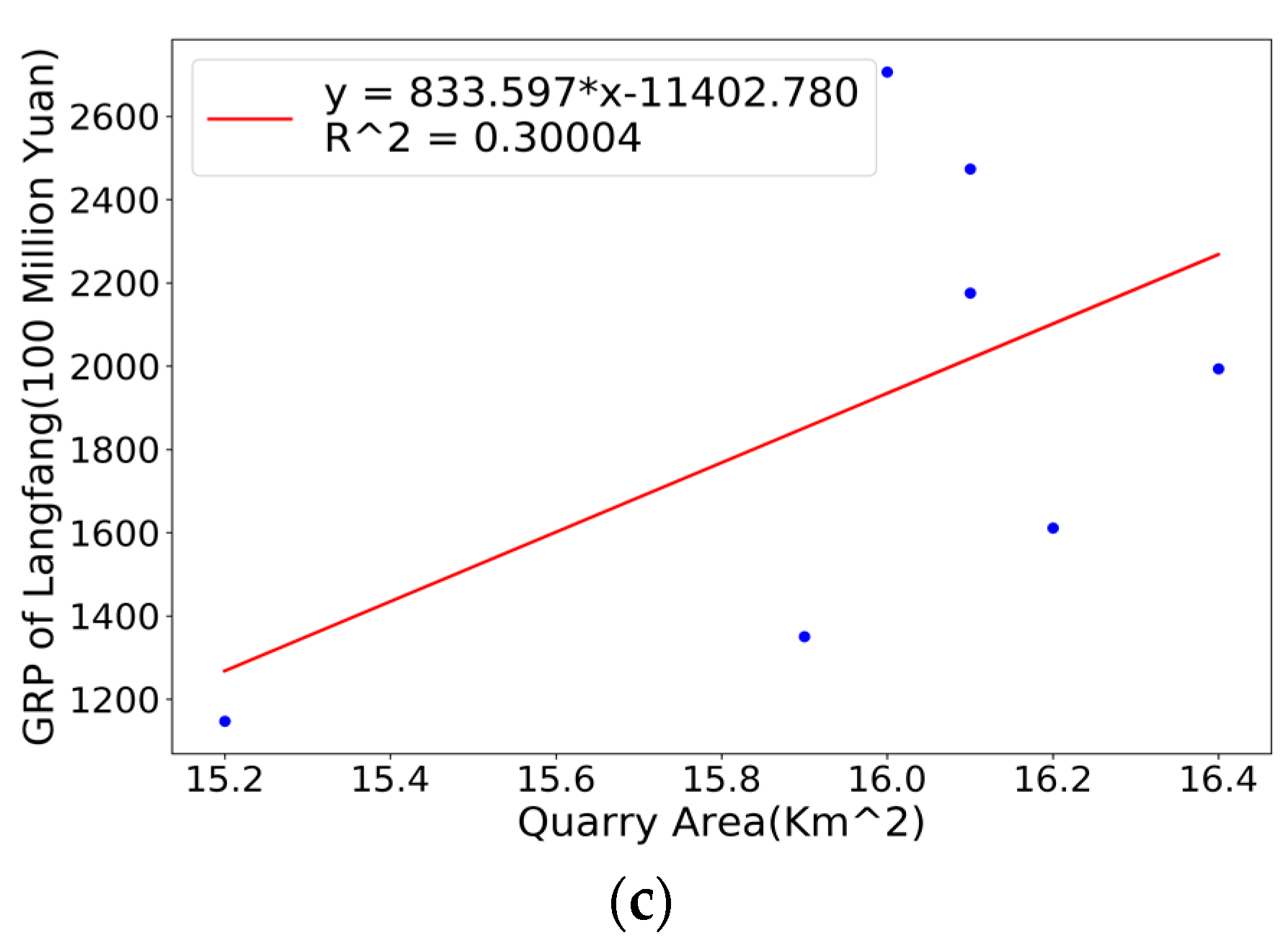
| Year | Class Name | |
|---|---|---|
| Quarry | Non-Quarry (Building, Forest, Farm, Bare Ground) | |
| 1984 | 431 (12) | 21,226 (46) |
| 1992 | 1429 (33) | 19,934 (47) |
| 2002 | 1517 (18) | 17,445 (43) |
| 2010 | 3341 (36) | 17,312 (42) |
| 2013 | 2791 (30) | 16,341 (43) |
| 2016 | 3828 (18) | 18,975 (31) |
| Year | M-OOB | Kappa | AUC | Year | OOB | Kappa | AUC |
|---|---|---|---|---|---|---|---|
| 1984 | 0.97339 | 0.94199 | 0.99608 | 2001 | 0.97936 | 0.94864 | 0.99724 |
| 1985 | 0.97353 | 0.93944 | 0.99366 | 2002 | 0.97177 | 0.92991 | 0.99689 |
| 1986 | 0.96850 | 0.93227 | 0.99343 | 2003 | 0.93379 | 0.81045 | 0.98081 |
| 1987 | 0.96300 | 0.91500 | 0.99635 | 2004 | 0.95965 | 0.90914 | 0.99326 |
| 1988 | 0.95909 | 0.91005 | 0.99283 | 2005 | 0.97118 | 0.92891 | 0.99508 |
| 1989 | 0.96172 | 0.90129 | 0.99500 | 2006 | 0.97269 | 0.94694 | 0.99616 |
| 1990 | 0.97850 | 0.95124 | 0.99854 | 2007 | 0.96985 | 0.92488 | 0.99293 |
| 1991 | 0.96458 | 0.91188 | 0.99433 | 2008 | 0.96660 | 0.93317 | 0.99408 |
| 1992 | 0.96921 | 0.92225 | 0.99530 | 2009 | 0.97748 | 0.95445 | 0.99669 |
| 1993 | 0.97177 | 0.91871 | 0.99290 | 2010 | 0.97391 | 0.93918 | 0.99476 |
| 1994 | 0.97711 | 0.94931 | 0.99450 | 2011 | 0.97780 | 0.95656 | 0.99722 |
| 1995 | 0.97324 | 0.94332 | 0.99479 | 2013 | 0.94541 | 0.89418 | 0.98797 |
| 1996 | 0.97278 | 0.93496 | 0.99144 | 2014 | 0.95515 | 0.90864 | 0.99157 |
| 1997 | 0.96842 | 0.92273 | 0.99193 | 2015 | 0.94397 | 0.88609 | 0.98819 |
| 1998 | 0.96799 | 0.93110 | 0.98967 | 2016 | 0.96577 | 0.93542 | 0.99557 |
| 1999 | 0.96782 | 0.92415 | 0.99157 | 2017 | 0.95537 | 0.91516 | 0.99353 |
| 2000 | 0.98299 | 0.95761 | 0.99817 |
© 2018 by the authors. Licensee MDPI, Basel, Switzerland. This article is an open access article distributed under the terms and conditions of the Creative Commons Attribution (CC BY) license (http://creativecommons.org/licenses/by/4.0/).
Share and Cite
Zhao, H.; Ma, Y.; Chen, F.; Liu, J.; Jiang, L.; Yao, W.; Yang, J. Monitoring Quarry Area with Landsat Long Time-Series for Socioeconomic Study. Remote Sens. 2018, 10, 517. https://doi.org/10.3390/rs10040517
Zhao H, Ma Y, Chen F, Liu J, Jiang L, Yao W, Yang J. Monitoring Quarry Area with Landsat Long Time-Series for Socioeconomic Study. Remote Sensing. 2018; 10(4):517. https://doi.org/10.3390/rs10040517
Chicago/Turabian StyleZhao, Haoteng, Yong Ma, Fu Chen, Jianbo Liu, Liyuan Jiang, Wutao Yao, and Jin Yang. 2018. "Monitoring Quarry Area with Landsat Long Time-Series for Socioeconomic Study" Remote Sensing 10, no. 4: 517. https://doi.org/10.3390/rs10040517






